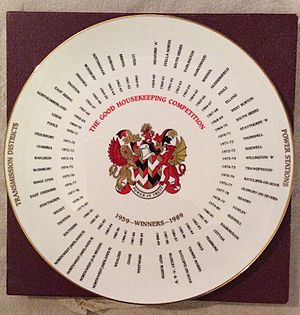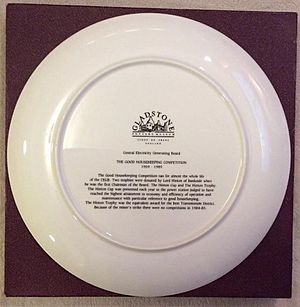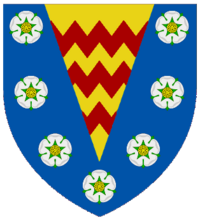Christopher Hinton, Baron Hinton of Bankside facts for kids
Quick facts for kids
The Lord Hinton of Bankside
|
|
|---|---|
 |
|
| Born | 12 May 1901 Tisbury, Wiltshire, England, UK
|
| Died | 22 June 1983 (aged 82) London, England, UK
|
| Nationality | British |
| Known for | Calder Hall |
| Awards | Wilhelm Exner Medal (1956) Castner Medal (1956) Albert Medal (1957) Rumford Medal (1970) James Watt International Medal (1973) Order of Merit (1976) |
| Scientific career | |
| Fields | Nuclear |
Christopher Hinton, Baron Hinton of Bankside (1901–1983) was a very important British engineer. He is famous for leading the building of Calder Hall. This was the world's first large power station to use nuclear power to make electricity for homes and businesses.
Contents
Christopher Hinton's Life and Work
Christopher Hinton was born in Tisbury, Wiltshire, England, on May 12, 1901. He went to school in Chippenham. At 16, he left school to become an engineering apprentice. This means he learned engineering skills by working for the Great Western Railway.
Later, at age 22, he won a special scholarship. This allowed him to study at Trinity College, Cambridge, a very famous university. He studied engineering there and graduated with top honors.
Early Career
After university, Hinton worked for a company called Brunner Mond. This company later became part of ICI. He was so good that he became the Chief Engineer at just 29 years old. While working there, he met Lillian Boyer, and they got married in 1931. They had one daughter named Mary.
During World War II, Hinton helped the British government. He was in charge of building factories that made important supplies for the war effort.
Building Nuclear Power
In 1946, Hinton started working on atomic energy. He was put in charge of building Britain's main nuclear plants. These included places like Windscale, Capenhurst, and Springfields. These plants were very important for developing nuclear technology in the UK.
In 1954, the Atomic Energy Authority was formed. Hinton became a key leader there. His team designed and built many of Britain's major nuclear facilities. This included Calder Hall, which was a huge step forward for nuclear power.
In 1957, Hinton became the first chairman of the Central Electricity Generating Board (CEGB). This organization was responsible for making and supplying electricity in Britain. He retired in 1964. Even after retiring, he kept an office at the CEGB headquarters.
Later Life and Awards
After leaving the CEGB, Hinton continued to work. He advised the World Bank on energy matters. He also led the International Executive Committee of the World Energy Conference.
In 1965, he was given the special title of Baron Hinton of Bankside. This made him a life peer, which is a high honor in Britain. He also served as the Chancellor of the University of Bath from 1966 to 1979. In 1976, he received the Order of Merit, one of the highest awards in the UK.
The Hinton Heavies
A famous architectural critic named Reyner Banham gave the name "Hinton Heavies" to some very large power stations. These were the first 500-megawatt (MW) power units ordered by the CEGB. They were a new design for their time.
Here are some of these "Hinton Heavies" power stations:
- West Burton in Nottinghamshire (2,000 MW)
- Ferrybridge 'C' in West Yorkshire (2,000 MW)
- Eggborough in North Yorkshire (2,000 MW)
- Kingsnorth in Kent (2,000 MW, oil fired)
- Fawley in Hampshire (2,000 MW, oil fired)
- Aberthaw ‘B’ in South Wales (1,500 MW)
- Ironbridge 'B' in Shropshire (1,000 MW)
- Fiddlers Ferry in Cheshire (2,000 MW)
- Ratcliffe in Nottinghamshire (2,000 MW)
- Cottam in Nottinghamshire (2,000 MW)
- Pembroke in South West Wales (2,000 MW, oil fired)
- Rugeley 'B' in Staffordshire (1,000 MW)
- Didcot 'A' in Oxfordshire (2,000 MW)
- Ince 'B' in Cheshire (1,000 MW, oil fired)
Later, these 500 MW units were made even bigger, to 660 MW. These larger units were built at places like Drax. Similar 660 MW machines were also used in Britain's AGR nuclear power stations. These were the largest power plants built by the CEGB before it was broken up in the 1990s.
The Hinton Cup and Hinton Trophy
While he was at the Central Electricity Generating Board, Christopher Hinton started a special award. It was called the Hinton Cup. This silver cup was given out every year to the power station that was best at "housekeeping." This meant keeping the workplace clean, efficient, and attractive.
The award's motto was: "This cup is presented to the Power Station judged to have reached the highest attainment in economy and efficiency of operation and maintenance with particular reference to attractiveness and good housekeeping."
Meaford A power station won the first Hinton Cup in 1959. West Burton Power Station won it last before the CEGB changed. The Hinton Trophy was a similar award for the best Transmission District.
To celebrate 30 years of these awards, a special plate was made.
Awards and Achievements
Christopher Hinton received many honors for his work:
- Knighted in 1951
- Became a Fellow of the Royal Society in 1954
- Received the Wilhelm Exner Medal in 1956
- Became a Knight Commander of the Order of the British Empire in 1957
- Became a Fellow of Trinity College in 1957
- Received honorary degrees from the University of Oxford (1957) and the University of Cambridge (1960)
- Was made a life peer as Baron Hinton of Bankside in 1965
- Served as President of the Institution of Mechanical Engineers in 1966
- Became a Foreign Associate of the National Academy of Engineering in 1976
- Received the Order of Merit in 1976
- Was Chancellor of the University of Bath from 1966 to 1980
- Received the James Watt International Medal in 1973
- Was the first President of the Royal Academy of Engineering
A British Rail Class 37 diesel locomotive (number 37409) was named "Lord Hinton" in his honor in 2010. A large ship, a bulk carrier, was also named "Lord Hinton."
|
| Academic offices | ||
|---|---|---|
| New institution | Chancellor of the University of Bath 1966–1980 |
Succeeded by Sir Frank Kearton |
| Professional and academic associations | ||
| Preceded by Harold Norman Gwynne Allen |
President of the Institution of Mechanical Engineers 1966 |
Succeeded by Hugh Graham Conway |
| Business positions | ||
| New title | Chairman of the Central Electricity Generating Board 1957–1964 |
Succeeded by Sir Stanley Brown |






